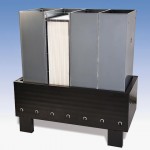With their small footprint and superior effluent quality, membrane bioreactors have set a new standard in wastewater treatment. Current challenges in operating membrane bioreactors are the control of membrane fouling and the reduction of operational expenses. To meet this need, Bio-Cel modules that combine the advantages of different module designs have now been developed, providing large membrane surface areas, preventing braiding and sludging and offering an efficient crossflow aeration system.
S. Krause, U. Meyer-Blumenroth, W. Lamparter
Membrane bioreactors (MBR) unite the activated sludge process (ASP) for wastewater treatment with biomass separation from the mixed liquor by ultra- or microfiltration membranes. In the majority of cases, these membranes are submerged directly into the activated sludge and the treated wastewater (permeate) is sucked by vacuum or gravity flow. As the membrane acts as a barrier, the effluent quality can be improved and the mixed liquor suspended solids (MLSS) concentration increased because no solids or bacteria can pass (the pore size of the membranes is in the region of 0.05 to 0.5 µm). In addition, the process is independent of sedimentation and no secondary sedimentation tanks are required. MBRs are usually operated at MLSS concentrations of about 10 g/l. Overall, the footprint savings of the treatment plant can be as much as 50 % compared to the conventional activated sludge process (CASP).
Current challenges in operating membrane bioreactors are the control of membrane fouling and the reduction of operational expenses. Blocking and braiding, which reduce the active membrane surface, are often observed in submerged modules. Braiding is caused by hairs and/or long fibres; these are more common in hollow fibre modules. There is hence a need for modules that provide large membrane surface areas, prevent braiding and sludging and offer an efficient crossflow aeration system. Membrane modules for biomass separation should also consist of chemically, thermal and mechanically resistant materials with consistent pore size contribution. Other features should be back-washable membranes, low flow resistance, high packing density and low specific weight as well as low energy requirements per unit volume of treated water. A modularised system with quick-change modules is particularly beneficial if the plant needs to be enlarged. The development steps of the new Bio-Cel module are discussed in the following.
Membrane design
The choice of materials was important during development. Mainly polymeric membranes are used. These membranes are manufactured with a high surface porosity and a narrow pore size distribution to assure a high throughput and a high selective degree of rejection. Only a limited number of materials are suitable for membranes in MBR applications, namely polyvinylidene difluoride (PVDF), polyether sulphone (PES), polyethylene (PE) and polypropylene (PP). A polyether sulphone (PES) ultra-filtration membrane was chosen to develop the Bio-Cel module owing to its hydrophilicity and low biofouling characteristics.
The heart of the developed membrane module is a backwashable, flat membrane sheet. Backwashability is achieved by laminating the membrane with a drainage layer. The challenge was to guarantee sufficient adhesion strength between the two layers while at the same time maintaining high water permeability. This also allows efficient in-situ cleaning by backwashing with chemicals. The pressure loss inside the membrane must be low in order to obtain a low flow resistance. This is especially important for (chemical) backwashing to ensure that all of the membrane pores are actually cleaned. A drainage system was consequently developed in which
the permeate suction is drawn from the middle of the membrane instead of the top or side. The 2 mm thin, self-supporting membrane sheets result in a higher packing density compared to plate and frame modules, which have a plate thickness of about 6 to 8 mm. The Bio-Cel module thus increases the packing density by more than 30 % with the same gap between membranes (approximately 8 mm). At the same time, the module has a lower specific weight because no plate supporting system is required. Hollow fibre systems have slightly higher packing densities but entail a risk of braiding and sludge deposits.
Module design
Flat membrane sheets were used to prevent braiding of the membranes because hairs or fibres cannot loop around them. The top and bottom of the module are open to prevent sludge deposits at the bottom. The hydraulic optimisation of the module eliminates dead zones where sludge can accumulate. A frameless module design is possible because the developed membrane sheets are self-supporting. The velocity at the membrane edge is sufficient to avoid sludge deposits owing to the guiding plates (baffles) inside the module that maintain a gap with respect to the membranes.
The module consists of two parts: a base frame, which also holds the crossflow aeration system, and the membranes, which are designed as exchangeable cassettes. Each cassette holds 25 or 100 m² membrane surface. Figure 1 shows the complete module (BC100-C100, 100 m²). The cassettes are self-supporting and connected in blocks of four. Only the cassettes and not the base frame need to be replaced in order to exchange the membrane. This unique design permits a reduction in the costs for membrane replacement. Figure 2 shows the newly developed BC400 cassette, whereby one cassette holds 100 m².
Efficient crossflow aeration
The efficiency of the crossflow aeration was determined by measuring the flow velocity. Different bubble diameters (from fine bubbles to a coarse bubble system) were examined. The measurements were performed using a Marsh-Mc. Birney 2000 Flomate flow meter.
The velocity of tap water was measured first in order to assess the bubble diameter and visualise the dispersion. Due to the transparency of CMC water, the viscosity was then altered using carboxymethyl cellulose (CMC) (Tylose H100000 YP2-DEAT 043780) to facilitate visualisation. In the last step, measurements were carried out in activated sludge. The airflow rate was from 0.3 to 0.7 m³ per m² of membrane surface. The goal was to achieve the optimal dispersion and maximum flow velocity along the membranes.
The energy consumers in MBR applications are the aeration systems for the oxygen supply and crossflow generation. Since the alpha factor is reduced as the MLSS increases, more energy is required for the oxygen supply than with CASP. Most of this energy is needed for crossflow generation. The main factors influencing the energy demand are the depth of submergence, the aeration rate and the flux. The specific airflow rate of the Bio-Cel modules is between 0.2 and 0.8 m³ N/m² h, which is comparable to other MBR modules. The depth of submergence is very shallow, as the module is only 1.35 m high. Depending on the flux and installation, the energy demand for crossflow induction is normally in the range from 0.2 to 0.5 kW h/m³.
MBR technology represents the next generation in wastewater treatment. The advantages of this process are its superior effluent quality, characterised by the complete removal of solids and bacteria, and the small plant footprint due to the more compact aeration tanks and the absence of a final sedimentation tank. Experience in recent years has shown that MBR applications are efficient and suitable for both municipal and industrial wastewater treatment.
cpp 436
Bio Cel Modules
IFAT 2008
Share:










